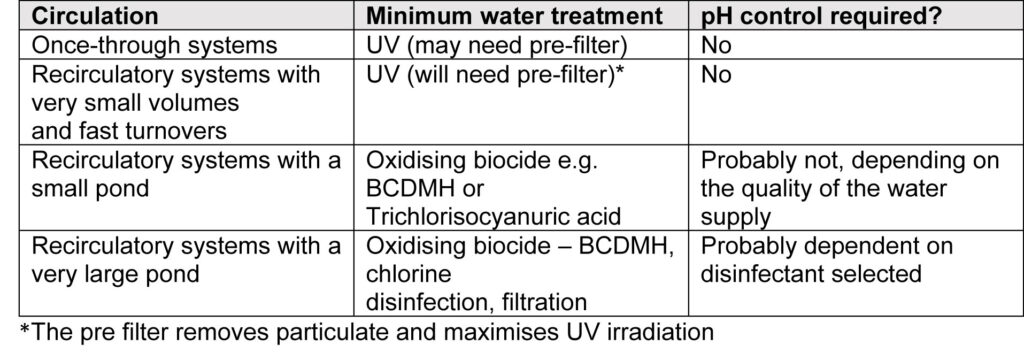PWTAG Technical notes are updates or new material for the standards and guidance given in the PWTAG book, Swimming Pool Water and the PWTAG Code of practice and should be read in association with these publications.
Decorative water features can be simply a traditional fountain surrounded by a pond, that is looked at, not interacted with, or ground-based jets across which the public may walk freely. It
is not realistic to restrict access to such features, although their use as play areas should not be encouraged. There should be warnings if they contain disinfectant or algicide, as they may impact health if ingested and they may stain or bleach clothes.
Some features are specifically designed for such play: their safe design and use are dealt with in PWTAG Technical note 13, Interactive water features and in our book, Swimming Pool Water. They are variously called waterparks, splash pads, spray parks and zero depth pools. They can include such features as geysers, rooster tails, mushrooms, spiral sprays, plaza features and ground gushers. As they are designed for children more or less dressed for a soaking, their water treatment and circulation should involve disinfection, filtration, separate tanks etc.
There are the more or less traditional fountain – perhaps in a public square, often surrounded by a pond, sometimes relatively small and decorative. Although not designed for interaction, people inevitably do play in them (Trafalgar Square notably) and even ingest their water. So their safe design and use is important. This technical note deals chiefly with that issue.
This technical note does not deal specifically with liabilities associated with people accessing these fountains, or other health and safety issues and liabilities such as slips, trip and falls or broken glass.
Treating the water?
Whether or not and how to treat water in a water feature is not always straightforward. The designer needs to consider multiple factors that could lead to loss of water quality, such as water source, hardness and phosphate content. The surrounding environment and aesthetics, as well as the ability for people to informally access them may also be relevant.
Risks from decorative water features can be inhalation of aerosols, ingestion of water and dermal contact. Obviously, inhalation of aerosols and droplets should be the most likely pathway, but fountains can be accessed informally, so ingestion and dermal contact cannot be ruled out.
If the fountain has a pond/pool, any debris – litter, bottles, leaves etc. – should be removed regularly and the circulating water should be disinfected, to suppress algal growth and reduce risks to the public from bacteria and viruses. If the water needs to look clear, filtration may be necessary. Clearly providing even a small, underground plantroom may be unrealistic, especially with older public space fountains.
But the ideal arrangement would be to have what an interactive water feature should have – two water tanks, and full circulation of treated, filtered water.
In practice, roadside pillars and covered pits can provide a cramped plantroom solution. If lift-assisted covers are not fitted, then manual handling limits may require cover lifting equipment to aid the operator. Crowd barriers should be erected to keep public from open plantroom risks and chemical handling. Vandalism can be an issue.
If there is no plantroom, then the minimum is scrupulous attention to removing any debris. A fountain pond may be hand dosed with disinfectant, but in measured, prescribed amounts – and monitored (see below).
Water treatment
Fountains are not subject to bather loads in the same way as swimming pools but especially outdoors, they are still subject to organic loads from pollen, bird droppings, leaves, litter and other wind-blown debris.
External fountains will all be exposed to UV light which, in the presence of organics and phosphates can promote algal growth. In such cases a means of phosphate control may need to be considered.
What then should the water treatment be, for different types of fountain water circulation?

In the light of increasing water stress and the need to preserve water in a changing climate, once-through systems should not be encouraged. If they are in use, they should be regularly tested and well maintained.
This technical note recognises that many older water features may have no water treatment, and no possibility of adding it. Certainly all new features should be equipped with recirculatory systems and appropriate filtration/disinfection and controls that are designed both to protect public health and,to conserve water. The requirement for filtration must be recognised at design stage by providing appropriate, ventilated plant room space and secure, safe provision for necessary chemicals storage.
As a basic rule if the water is not clear then, filtration is necessary. If older water features are unable to deliver clear water without filtration and cannot be upgraded, then, they cannot be considered as safe and should be drained. If there is no plantroom, then the minimum requirement is scrupulous attention to removing any debris and regular, weekly, programmed drainage, cleaning and disinfection. A fountain pond/pool may be hand dosed with disinfectant but, if clear, consistent, and safe water quality cannot be achieved then the facility should be drained.
Oxidising biocides should be maintained at 3-5mg/l for chlorine-based products and 4-6mg/l if bromine based. The pH should be maintained at 7.0-7.4 for chlorine-based products and 7.4-8.2 for bromine. Measuring and recording these parameters is a job requiring the regular attendance of a suitably trained operator.
Risk assessment
This is necessary, and should cover unintended as well as intended use. It should cover microbiological risks, including Legionella. (HSE guidance, including its code of practice is instructive.) A specific risk is Weil’s disease, which can derive from rat’s urine. Clearly it is important that rats do not have access to fountain ponds.
Excluding dogs and other pets is important, but bird faeces will inevitably be introduced. The public may introduce chemicals that foam, or even ones that might harm. All these may be an issue after a big public event.
Operators should follow the new BS 8580-2:2022 Water Quality Part 2: Risk assessments for Pseudomonas aeruginosa and other waterborne pathogens – Code of Practice. Physical risks, including drowning, should be included.
The use of fountains inside public buildings (hotels, conference centres etc.) is particularly tricky, because of the aerosols inevitably produced. These types of water feature are particularly unsuitable for hospitals and other healthcare setting.
There should be signs warning people not to drink or play with the water; also that children should be supervised.
Maintenance
All public decorative water features should have a written maintenance manual incorporating any and all necessary instruction and management, maintenance, and safety protocols provided by equipment manufacturers and chemical suppliers. The manual should be updated by the operator as and when any system modifications or chemical dosing changes are made.
If the water becomes cloudy or smelly it should be drained, the structure cleaned and disinfected. This applies also if the water treatment is switched off for two days or more, as the water will have become stagnant. It is particularly important in dusty areas.
Fountain pond water should be as cool as possible; submerged, heat-generating lighting should be avoided. Water temperature should be checked routinely since temperatures in excess of 20oC are conducive to the growth of Legionellae.
A maintenance log should be maintained – free chlorine levels, water temperature, visual inspection for cloudy water and areas of slime, filter inspections, filter cleaning, filter changes, pump cleaning (every 3 months), water changes and routine cleaning . The dose rate for UV should be a minimum of 40mJ/cm 2.
Cleaning and maintenance should form part of the overall risk management strategy. Someone competent should be responsible for maintaining the feature. The fountain should be included in the operator’s normal infection control environmental sampling programme.
- Subject: Interactive water features
- Date: February 2024
- Download: Technical Note 67 PDF
